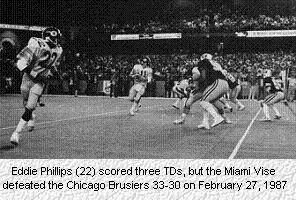

Tampa Bay Storm Prologue



Tampa Bay Storm Prologue
Jim Foster played football at the University of Iowa and was a minor league football executive of the year before becoming a promotions manager for National Football League Properties. By early 1982, he had plans in motion to develop indoor football. However, when the United States Football League announced it would play spring football beginning in 1983, those plans were put on hold. Foster ended up working for Arizona and Chicago of the USFL, but when the league voted to go to a fall season, Foster left to pursue the concept of arena football.
 On April 26, 1986, a test game took place at the Rockford (Illinois) Metro
Center. The Rockford Metros and the Chicago Politicians, comprised of semi-pro
and minor league players sworn to secrecy, helped develop the rules for indoor
football. After that game, Darrel "Mouse" Davis, arena football's Director of
Football Operations, tweaked the rules and formations. Famous for the the "Run
and Shoot" offense, Davis created the high scoring game of today. After the
ESPN cable TV network showed interest in a video tape of that game, a second
trial game took place. On February 26, 1987, the Chicago Bruisers and Miami
Vise played before 8,527 fans at the Rosemont Horizon near Chicago. ESPN
televised this "Showcase Game" and the favorable response lead to the first
season for the Arena Football League.
On April 26, 1986, a test game took place at the Rockford (Illinois) Metro
Center. The Rockford Metros and the Chicago Politicians, comprised of semi-pro
and minor league players sworn to secrecy, helped develop the rules for indoor
football. After that game, Darrel "Mouse" Davis, arena football's Director of
Football Operations, tweaked the rules and formations. Famous for the the "Run
and Shoot" offense, Davis created the high scoring game of today. After the
ESPN cable TV network showed interest in a video tape of that game, a second
trial game took place. On February 26, 1987, the Chicago Bruisers and Miami
Vise played before 8,527 fans at the Rosemont Horizon near Chicago. ESPN
televised this "Showcase Game" and the favorable response lead to the first
season for the Arena Football League.
The Chicago Bruisers, Denver Dynamite, Pittsburgh Gladiators and Washington (DC) Commandos played a six game schedule in that first "Preview Season." On June 19, 1987 the first regular season game took place in Pittsburgh before 12,117 fans. The Gladiators topped the visiting Commandos 48-46. Denver, behind Coach of the Year Tim Marcum, won the first Arena Bowl championship over Pittsburgh 45-16. The following season, the schedule length doubled to twelve games and the league added a couple of teams. While the Detroit Drive won the first of four league titles, the AFL almost went out of business. The financial structure of the league could not handle the rapid growth and changes were necessary for survival. Five teams, playing a four game schedule, did manage to salvage a 1989 season. In an attempt to broaden the indoor game's appeal, games were played at five non-league cities in what was billed as a "Touring Season."
Before moving to Tampa Bay, the Storm franchise played in Pittsburgh. The Pittsburgh Gladiators were one of the four original Arena Football League teams, so the Pittsburgh/Tampa Bay franchise is the only one
 existing from the league’s inaugural season in 1987. existing from the league’s inaugural season in 1987.
The Gladiators never won the championship, but did compete in the Arena Bowl twice during those four years. Pittsburgh hosted the first-ever Arena Bowl, but lost to Denver 45-16. In 1989 the Gladiators lost in Detroit to the Drive in Arena Bowl III 39-26. Ironically, both of those losses came to teams coached by Tim Marcum. |
On November 16, 1990, Pittsburgh Gladiators owner Bob Gries, citing lackluster attendance and operating losses, announced he would move the franchise to the Tampa Bay area for the 1991 season. The Gries family had owned 48 percent of the Cleveland Browns since 1946 and Bob Gries sat on the Browns Board of Directors. At a press conference in St. Petersburg, held on November 20, Gries spoke of playing home games at the Florida Suncoast Dome. "I had the chance to take this team anywhere in the country. I checked out Portland, Atlanta and Charlotte, and this was by far the number one site. There are no negatives. I think we can do 20,000 here."
 A "Name the Team" contest was held and a couple of factors contributed to the
selection. One reason was the Tampa Bay area's weather extremes. Also, at
that time, the Persian Gulf War was in full swing and Tampa's MacDill Air Force
Base served as a headquarters for Operation Desert Storm. On March 12, 1991,
the announcement was made and the team became the Tampa Bay Storm. The team
colors would be red, white and blue.
A "Name the Team" contest was held and a couple of factors contributed to the
selection. One reason was the Tampa Bay area's weather extremes. Also, at
that time, the Persian Gulf War was in full swing and Tampa's MacDill Air Force
Base served as a headquarters for Operation Desert Storm. On March 12, 1991,
the announcement was made and the team became the Tampa Bay Storm. The team
colors would be red, white and blue.
| Related Links |
| Arena Bowl Results |
| Back to Tampa Bay Storm History Page |
| Back to Tampa Bay Storm Main Menu |
| Back to Home Page |